Inside enemy tunnels and the concrete jungle of Marawi
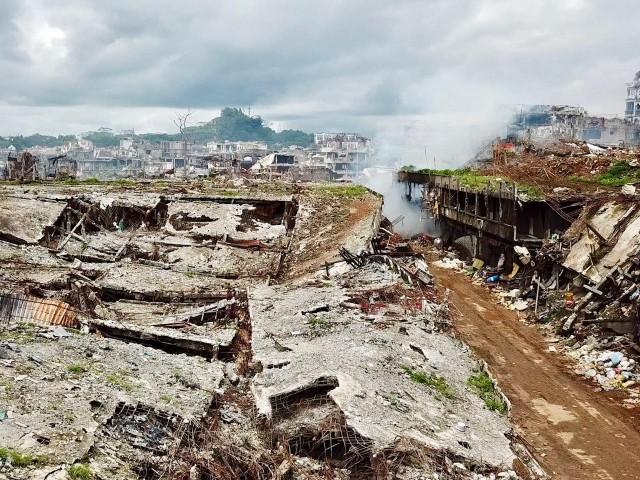
It was my third time inside the main battle area. But according to members of the Third Scout Ranger Battalion I was with, this would be the first time a journalist will see the tunnel system their enemies used in the cat and mouse game to retake the city of Marawi.
For journalists who covered the battle of Marawi, the main battle area (MBA) was for the most part a mystery.
Stories of how the terrorist group used extensive tunnel systems and fortified sniper positions to hold on to Marawi for almost five months were never really independently verified.
Until now.
The Scout Rangers led me to a two-storey house where, for weeks, snipers halted their advance into the city.
The elite soldiers said they could not even cross the street because of M203 grenade and sniper fires coming from this house.
One soldier tried.
But he was struck in the shoulder, a sniper's bullet exited through his face, shattering his jaw.
Vastly superior in firepower, the Scout Rangers hit the house with all they have until the sniper's gun fell silent.
But as soon as they entered the house, the volley of enemy gunfire returned.
That’s when the lead scout saw the small hole on the farthest wall of the living room, spitting out flashes of hot lead, the bullets coming straight at him.
Undeterred, he fired back forcing his adversary to stop.
More Scout Rangers poured into the room guns blazing towards that small hole on the wall.
And then silence.
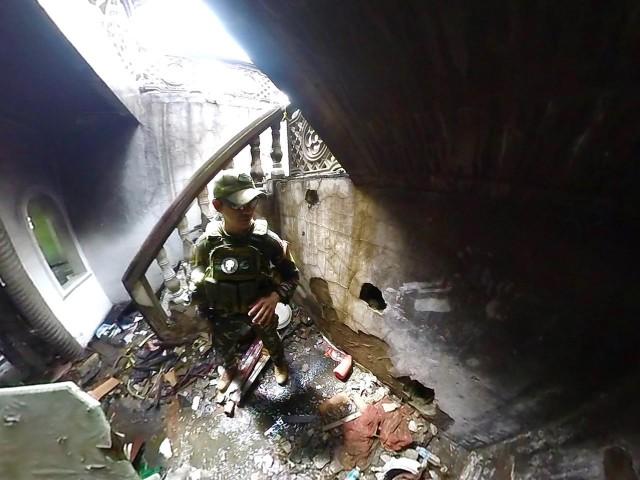
The soldiers cautiously advanced, expecting the sniper on the other side of the wall to be either dead or gravely wounded.
But as they've been repeatedly told during close quarter battle training: the danger is not over until you open the door and see the body of the enemy.
They had to clear one more room before they could finally reach the small door leading to the sniper's nest, a storage room underneath the staircase.
Opening the small door wide enough for a hand grenade, a soldier tossed one inside. Seconds after it exploded, they barged in.
But the sniper was gone.
The soldiers' account still fresh in my head, I entered the house through a gaping hole on the wall.
It is likely that the sniper assigned here was a foreign fighter, according to the Scout Rangers.
These so-called jihadists were assigned in strategic positions, their sniper’s nest usually close to an escape route allowing them to reposition without surfacing on the streets.
The foreign fighters, the soldiers said, were very valued by the terrorist group.
The tunnel
When I entered the sniper's nest, the faint smell of gunpowder mixed with the distinct odor of damp soil hit my nose.
Five feet from the snipers hole was the entrance to a tunnel dug on the concrete floor. The soil from the tunnel had been packed in sacks and used as protective sandbags.
The tunnel was shallow, only five-foot deep. At the bottom, it split into two passageways.
The soldiers said one led to the house across the street and the other to an exit at the back of the house.
The Scout Rangers took me there. The entrance was big enough for me to squat. Eight feet in, the tunnel started to diverge into two passageways: one led to the entrance of the house and the other seemed to lead to a nearby street which had a relatively new sewage line.
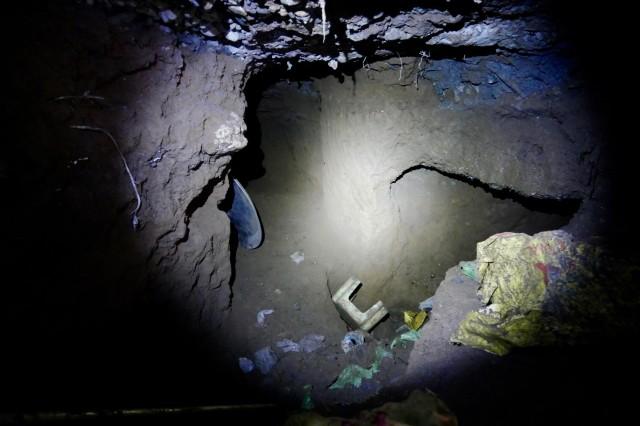
I did not dare go farther. The tunnel has not been fully cleared.
Imagining the last few moments before the house was taken over by the scout rangers, the sniper might have used the tunnel to escape either to the house across the street or to the sewage line.
The operation to take over the house took two days and a whole company of elite soldiers. Their enemy — not less than five but no more than 10 — all managed to escape.
As we made our way out of the compound, the soldiers led me to an adjoining house, which was completely burned to the ground, except for its concrete walls.
They said that just before they overran the snipers house, a fire broke out spreading to nearby houses — a terrorist tactic, according to soldiers, to cover their escape and to deny government forces the use of the sniper’s house as a defensive position.
We finally exited onto the street where soldiers pointed to a blown up hole in the sewage line.
They had to do it, they said, in an attempt to intercept the escaping terrorists. But the bad guys slipped away just the same.
The Scout Rangers pointed out that this was a classic example of how the terrorist group had managed to elude them and hold on to the city for more than four months.
Collapsed mosque
We then board a military truck and made our way to another part of Marawi. Snaking our way around collapsed buildings and burned down houses, it became increasingly clear how tough the battle to retake Marawi had been.
The truck stopped near the Marawi City Police Station. This was one of the first places attacked by the terrorist group at the start of the crisis in late May.
Beside it was a toppled minaret of what was once a mosque. The whole structure had collapsed and the buildings around it, all reduced to rubble.
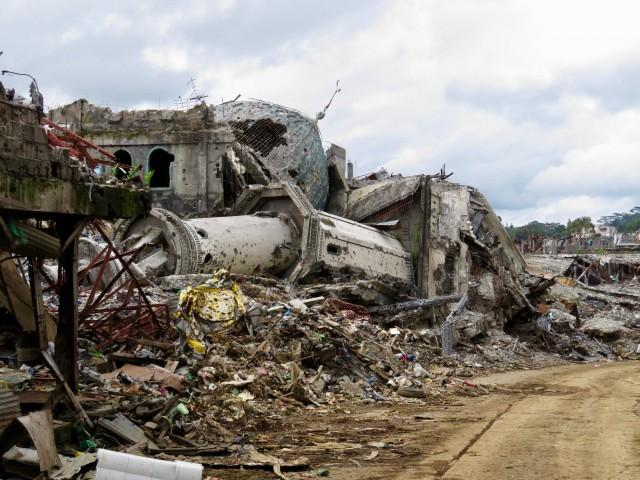
The soldiers claimed the mosque collapsed because its walls had been weakened by repeated rocket propelled grenade strikes by the terrorists themselves from inside the structure.
Wanting to hit the tanks positioned outside, the terrorists, the Scout Ranged told me, would apparently fire their RPG’s from inside the mosque through their sniper holes. Some went through but others exploded on the walls of the mosque itself.
But the soldiers admitted that a bomb from an FA-50 fighter jet that made a direct hit on the building next to it could have also contributed to the damage.
This was a scene from probably one of the most intense battles throughout the almost five-month long effort to retake the city.
Not included in their sector, the Third Scout Ranger Battalion was ordered to this mosque to help members of the 51st Infantry Battalion.
The Army unit suffered heavy casualties while trying to clear the mosque, with more than 40 getting wounded in a single day.
When the Scout Rangers arrived, the wounded soldiers have been evacuated, save for one.
The soldier lay motionless in the open, any attempt to rescue him thwarted by intense enemy fire from inside the mosque.
Even after realizing the soldier was dead, the Scout Rangers refused to give up. A plan was made.
They will inch their way to the mosque by building a wall made up sandbags and oil drums packed with soil.
Protected by cover fire from a tank and their sniper, the soldiers rolled the drums to the open field, stood it upright and stacked sandbags on top.
Under constant sniper and automatic gunfire, they did this repeatedly until the wall got longer and higher.
After almost three days, they got close enough for the elite Scout Rangers to safely cross the open field and enter the mosque.
Faced with an elite force they failed to stop, the terrorists withdrew to the basement.
As the Scout Rangers picked the body of their slain comrade, not a single shot was heard from the terrorists, as if a sign of respect for an enemies' resolve to bring back their own.
Indeed as soldiers, against all odds, nobody should be left behind.
But when the smoke cleared, the Scout Ranger sniper who provided cover fire for the rescuers lay dead. He was hit in the chest by an enemy sniper.
When I got to the mosque, the wall was gone. They had to position the tank near the mosque to complete the clearing operation.
We made our way near the top of the rubble and entered a small gap in the collapsed building, a decomposing corpse of a cat greeted us as we slid inside.
The mosque may have been destroyed but the first floor was still intact.
The soldiers then led me to the basement.
The place was pitch black with only our flashlights illuminating our way as we navigated around pieces of concrete, personal belongings and furnitures strewn all over the place.
The company commander of the Scout Rangers I was with said this place was rigged with improvised explosive devices (IED) when they first entered it.
But the terrorists never got to detonate the explosives as they fled.
Inside, the soldiers pointed to more tunnels, one of which still had a sleeping mat inside. The tunnel had been dug on the side of the wall connecting the adjoining buildings.
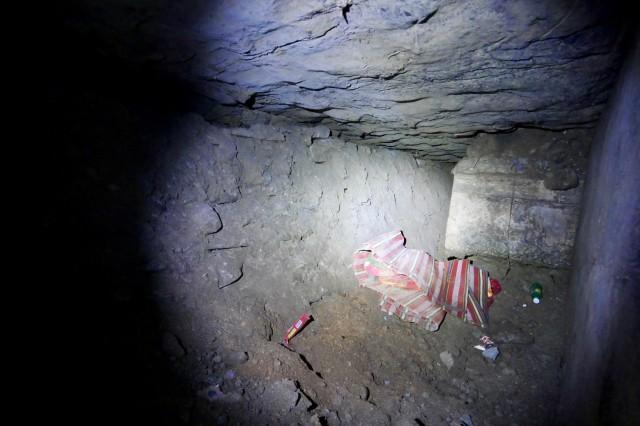
It took the Scout Rangers two more weeks to flush out the terrorists holed up in the entire block.
Trained mainly in jungle warfare, the Scout Rangers learned to clear buildings as they went along.
We emerged on the other side of the block approximately 50 meters from where we entered. In front of us was the ruins of Padian, the sprawling old market of the city.
The soldiers said this was also one of the key reasons why the terrorists managed to survive in those five months.
The market had hundreds of stalls selling everything from dry goods to grocery items and even medicine. And with Ramadan about to start when the crisis began, most food stores already had their month-long supply delivered.
The terrorists had everything they needed inside the main battle area.
As we made our way to the exact spot where terrorist leaders Hapilon and Omar Maute were killed, I heard several explosions and a couple of gunfires.
Just part of the ongoing clearing operation, the soldiers said.
At the outskirts of the city block where the terrorists made their last stand, we were stopped. A radio communication came in telling everyone in the area to stay put.
A huge detonation will be carried out.
In the building where we sheltered, two huge holes on the concrete floor indicated that the terrorists had tried to dig a tunnel, but they only got to about three feet.
Up to the last minute, it seemed the terrorist group tried to employ their tunneling technique.
Concrete jungle
On one side of the room, three crates of molotov bombs made from soft drink bottles lay unused.
The scout rangers said these gasoline-filled bottles were extensively used by the terrorists in burning buildings and houses that they would abandon before escaping.
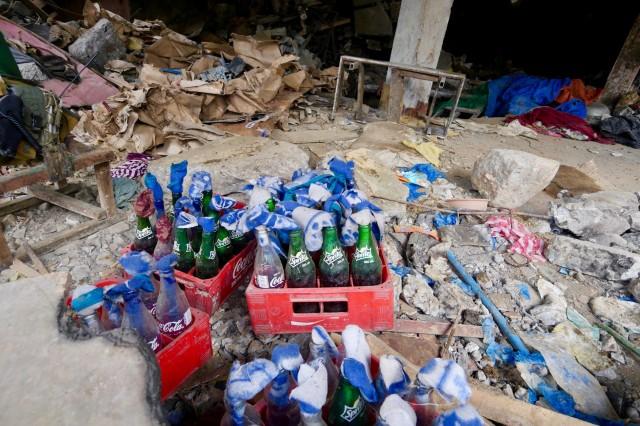
In several instances, the terrorists would use these molotov bombs to torch houses with soldiers inside. The body of two government forces last to be recovered died this way, the soldiers told me.
Ten minutes later, I heard a muffled but thunderous explosion. Then we were finally given the "all clear" signal to proceed.
On the road where the two terroist leaders had been gunned down, two tanks still stood guard. The area has not been fully cleared.
The two Scout Rangers who pulled the terrorist leaders from the street told me they had no idea that the two men sprawled face first on the dirt road were high-value targets.
Only when they turned one over did they recognize Hapilon.
The Scout Rangers were very familiar with the man.
Afterall, they had long been hunting down the Abu Sayyaf leader in the jungles of Sulu and Basilan for years.
And outside the confines of Hapilon's jungle territory, government troops finally got their target in the concrete jungles of Marawi.
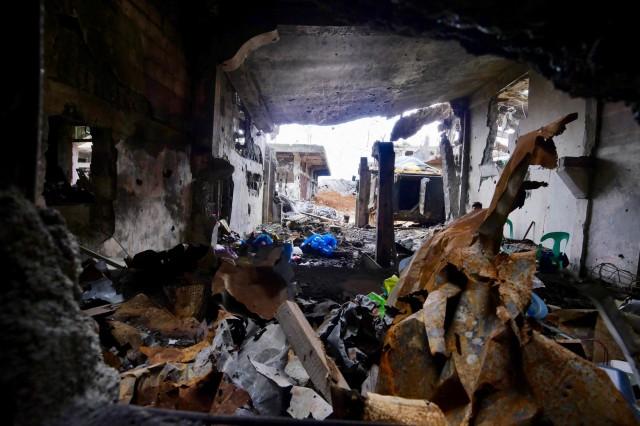
As we left the area, one Scout Ranger commented how it was so easy for people to say that too many government forces got killed in the operation to retake Marawi, 165 to be exact.
How people said the military seemed to have taken far too long and the destruction far too much. But they were not here, the Scout Ranger said. We were. And we won.
I would later learn while I was in the area, at least one building still had five to eight terrorists holed up inside.
Over a week after Hapilon and Omar Maute were killed and days after the military declared the combat operation was over, the fighting has not stopped.
The source said for four days, government troops tried to flush out terrorists hiding in a basement of one of the buildings in the area where I had been.
First with teargas, then with hand grenades and even IEDs and later with burning tires.
But the soldiers were still met with automatic gunfire when they tried to enter the building.
One solution was proposed. Collapse the whole building.
The source said he didn’t know if this was done.
The AFP denied such a plan was carried out.
The explosions from inside the main battle area were controlled detonation of unexploded bombs and IEDs, the military said.
That's when I recalled the thunderous explosion I heard while inside the MBA.
The war maybe over, but the mystery of the main battle area remains. — MDM/ALG, GMA News



